Introduction
How to address the challenge of conversion
Conversion to organic farming describes the process of learning and implementation of changes on the farm towards a more sustainable and natural way of farming. The form the process takes depends on the local circumstances and the predisposition of the farmer or the community, and it varies from farm to farm. The more knowledge a farmer has about the concepts and practices of organic farming, the more he or she relies on farm own or local resources to maintain soil fertility and on natural processes to manage pests and diseases, the closer the farm is to ‘organic’ and the easier conversion to organic farming will be. Even if organic farming does not depend on specific land conditions to start with, if soils are depleted for example, it may need greater efforts and require more patience to establish a sustainable production system and realize satisfying harvests.
How can conversion of such farms be attained?
Farm visit or discussion on the challenges of converting an intensively managed farm
Visit a conventional farm that was converted to organic farming, if available. Let the farmer share her experiences with converting the farm. Which challenges did he face? Which benefits resulted from conversion? Which recommendations would he give to other conventional farmers interested in conversion?
Alternatively, compare the scenario of an intensively managed farm with that of an organic farm. Discuss with the farmers the differences between the two scenarios. Which challenges and potential do they recognize in conversion?
a. Farms with high external input use
The majority of intensively managed farms in Africa that strongly rely on external inputs are larger farms. Such farms mostly grow a few annual or perennial cash crops relying heavily on the use of fertilizers for plant nutrition and pesticides and herbicides for pest, disease and weed control. On such farms crops are often grown without a planned rotation and farm animals are not integrated into the nutrient cycle. Diversification is usually low on these farms. Trees and bushes are mostly removed to facilitate extensive mechanization, and crops are mostly grown alone.
Potential challenges in conversion of such farms:
- Establishing a diverse and balanced farming system with a natural ability to regulate itself usually takes several years.
- Major efforts may be necessary to restore natural soil fertility by providing a considerable amount of organic matter to the soil.
- Abandoning high input external fertilizers results in yield depression in the first years of conversion, before soil fertility is re-established and yields rise again.
- New approaches and practices usually involve a lot of learning and intensive observation of crop development, and dynamics of pests, diseases and natural enemies.
How can conversion of such farms be attained?
- Diversify the farming system. Select appropriate annual crops for the area and rotate them in a planned sequence. Include legume crops such as beans or leguminous feed crops in the rotation to provide nitrogen to the subsequent crops. Plant hedges and flower strips to encourage natural enemies and to control pests.
- Start recycling valuable farm by-products. Establish on-farm compost production based on harvest residues and manure, if available, and mix the compost with the topsoil. This will bring stable organic matter into the soil and improve its structure and its capacity to feed the plants and store water. Green manures can provide plenty of plant material to feed soil organisms and build up soil fertility.
- Introduce farm animals into the system. Farm animals provide valuable manure and diversify farm income through additional animal products.
- Grow cover crops. Cover crops or lay out mulches in perennial crops provide protection to the soil.
Assessment of local farming practices
Inquire about the farmers’ way of farming by asking them the following questions:
- How do you fertilize your soils?
- How do you manage pests and diseases?
- Which crops do you grow?
- Do you have any farm animals?
- Do you grow food for subsistence only or also for the market?
- If you grow for a market, to which market(s) do you sell?
b. Farms with low external input use
Farmers working with little external inputs based on traditional practices may grow many different crops in a densely mixed system on the same piece of land changing crops randomly. A few livestock such as chickens and goats may be kept, which scatter the manure in their feeding places, hence providing very little manure for the gardens. The trees may be extensively cut for firewood and charcoal burning. Bush and trash burning may be a common practise especially during land preparation. Few or no externally-sourced fertilizers and pesticides may be used because they are expensive or difficult to purchase. Harvests are probably low and increasingly becoming difficult due to unreliable and insufficient rains. The harvests may just be sufficient for feeding the family and little may be left to sell for income.
Farm visit on the challenges of conversion of a traditionally managed farm
Alternatively, together with the farmers, characterise traditional farming as it is practiced in the local context and compare it with the one of the organic farm. Discuss with the farmers the differences between the pictures. Which challenges and potential do they recognize in conversion? Visit a conventional farm that was converted to organic farming, if available. Let the farmer share her experiences with conversion of the farm. Which challenges did she face? Which benefits resulted from conversion? Which recommendations would she give to other conventional farmers interested in conversion?
How can conversion of such farms be attained?
Traditional farmers fulfil some principles of organic farming already by relying on farm-own resources, growing different crops simultaneously and managing diverse enterprises including animals. Using few or no synthetic farm inputs and genetically modified plant varieties is another practice that increases the similarities between such traditional farms and organic farms. However, there are still practices, which clearly distinguish such farms from organic farms. The following challenges need to be addressed for conversion:
- Avoid burning of crop residues after harvest as this is, in most cases, not a viable solution, since it destroys valuable organic material and damages soil organisms.
- Establish a well organised diversification systems including a ‘planned’ crop rotation and intercropping systems.
- Accumulate knowledge and practice regarding efficient use of farm own resources, especially for compost production to manage and improve soil fertility.
- Indiscriminate tree cutting for firewood and charcoal burning.
- Establish a system to collect the animal manure for composting.
- Apply measures to prevent loss of soil through erosion and protect it from drying out.
- Pay special attention to satisfy feed and health requirements of the farm animals.
- Avoid infection of seeds with diseases, gain knowledge on disease cycles and preventive measures.
- Avoid harvest and storage losses.
Priority organic recommendations for conversion:
- Implement planned crop rotation and intercropping systems. A combination of annual and perennial crops including leguminous green manure cover crops is needed. Combined with properly selected or improved crop varieties with good resistance to, plant pests and diseases will be managed better.
- Proper integration of animals into the farming system. Planting rows of nitrogen fixing trees between annual crops will improve the growing conditions for the crops and encourage better growth, while providing additional feed for the ruminant animals. Better housing is also needed to facilitate collection of animal manure for field use.
- Improving the fertility of the soils, for example, through the application of high quality compost. Compost is a highly valuable fertilizer in organic farming. Instead of burning the crop residues after harvest, collect them for compost production, or work them into the soil. The animal manures and plant materials should be regularly collected for compost making.
- Growing nitrogen fixing legumes between annual crops is another possibility to feed the soil and the crops.
- Additional measures to control soil erosion such as digging trenches and planting trees along the hillside, and covering the soil with living or dead plant material should be implemented.
c. Mixed farm
On mixed farms, crops and farm animals may be integrated, whereby the animal manure is collected and used in the gardens after having kept it for a few weeks to rot. Some soil conservation measures may be implemented, such as mulching in perennial crops and trenches to reduce erosion. Occasionally herbicides, pesticides and treated seeds may be used to control weeds in fruit and vegetable production.
Farmers of such mixed farms are obviously familiar with some of the organic farming practices. Such farmers will find it easy to learn new methods from other farmers or from a trainer and to implement organic practices only, throughout the farm.
Priority recommendations for organic conversion:
- Implement organic practices to manage the soil and to control weeds instead of using herbicides. For example, in fruit orchards grow a leguminous cover crop to cover the soil. Or in vegetables and arable crops implement a planned crop rotation that includes weed suppressing green manure or feed crops.
- Further improve recycling of farm own nutrients from animals and crop residues to make best uses of them, for example by mixing them with crop residues for making compost. Improve storage of animal manures to avoid nutrient losses.
- Use seeds without pesticide-treatments, if available. Make sure to use healthy seeds only and get familiar with non-chemical ways of treating seeds.
- Get familiar with approaches and methods of natural pest and disease control. Learn about beneficial insects and observe population dynamics of pests through regular monitoring during crop growth.
- Further diversify the farming system to increase productivity of the land and provide habitats for beneficial insects and spiders.
d. Degraded land
Land may be degraded due to shifting cultivation, overgrazing, over-cultivation or deforestation, salinity after years of intensive irrigation with ground water, or water logging and flooding. Such land may take more effort and patience to establish good growing conditions. At the same time, organic practices are an excellent approach to recover such soils. It may require specific practices to stop soil degradation and to re-establish soil fertility. Such practices include digging of terraces or sowing an intensive fallow with a leguminous green manure crop that grows well on poor soils.
Many experiences show that organic farming is a promising approach to improve degraded land and bring it back into production. In most cases, the increase of organic matter plays a key role to improve the quality of degraded soils.
In case of a bare and eroded soil on sloping land, organic farming calls for digging of terraces (e.g. fanya juu terraces). Fanya juu (‘throw it upwards’ in Kiswahili) terraces are made by digging trenches along the contours and throwing the soil uphill to form embankments (bunds), which are stabilized with fodder grass like Napier (Pennisentum purpureum) and multipurpose agroforestry trees. The space between the embankments is cultivated with crops and over time, the fanya juu develop into bench terraces. They are useful in semi-arid areas to harvest and conserve water. Additionally, green manures and compost can be used to further build the soil to support good crop growth and yields.
Saline soils contain large amounts of water soluble salts that inhibit seed germination and plant growth. These salts may have been accumulated through excessive use of irrigation water, especially in arid and semi-arid climates. These salts can be reduced slowly by ensuring proper irrigation and building up the structure of the soil with compost to allow natural drainage of the excess salts. In a first period salt tolerant crops may be grown.
Acid soils can be reclaimed by adding lime and well-made compost.
Flooded soils can be improved by creating drainage channels to drain off the excess water.
Learn more about soil conservation and soil fertility management practices here.
Farm visit on regeneration of degraded land
Take the farmers to visit a farmer who has made efforts to stop erosion and that has improved her soil with compost, green manuring or leguminous cover crops. Let her share her experiences. How did she start? What measures proved effective to regenerate the land? What lessons did she learn? Discuss challenges and successes with the farmer.
Case study: Tigray Project in Ethiopia - Improving degenerated land through organic practices
In 1996, four villages of the Tigray region in Ethiopia started replacing synthetic fertilizers with compost to improve soil fertility and yields. Within 12 years the project had been extended by the government to 165 districts throughout the regional state following the same approach. Since the positive effects of the compost were seen very quickly, the farmers relied exclusively on compost within 2 to 3 years. Application of compost generally doubled the grain yields compared to the yields from plots with no inputs. The use of compost resulted in even higher yields than those achieved with synthetic fertilizers. Improved soil fertility and water retention enabled farmers to grow a greater diversity of crops, improving the resilience of their farms, providing better nutrition to the farm families and offering new income opportunities.
Climate-related challenges to conversion
Converting a farm to organic farming in an area with very little rainfall and high temperatures or strong winds will be more challenging than converting a farm located in an area with well distributed rainfall and favourable temperatures. At the same time, the improvements that follow implementation of organic practices will be more obvious under arid conditions than under ideal humid conditions. For example, compost application into topsoil or into planting holes will increase the soils water retention capacity and the crop’s tolerance to water scarcity.
In very warm and dry climate, losses of water through transpiration from plants and evaporation from soils are high. These losses may be further encouraged by strong winds, enhancing soil erosion. The soils’ organic matter content is generally low, as biomass production is low, implying that the availability of nutrients to the plants is highly reduced.
Under such conditions, the key to increasing crop productivity lies in protecting the soil from strong sun and wind and increasing the supply of organic matter and water to the soil. Soil organic matter can either be increased through compost or through cultivation of green manure crops. In the case of compost production the challenge is to increase production of plant biomass, which is needed for compost production.
In warm and humid climate, high aboveground biomass production and rapid decomposition of soil organic matter imply that the nutrients are easily made available to the plants. But it also involves a high risk that the nutrients are easily washed out and lost. Under such conditions a balance between production and decomposition of organic matter is important to avoid depletion of soil. Combining different practices to protect the soil and feed it with organic matter proves to be the most effective approach to choose. These practices include creating a diverse and multi-layer cropping system ideally including trees, growing nitrogen-fixing cover crops in orchards and applying compost to enrich the soil with organic matter and in this way increase its capacity to retain water and nutrients.
Discussion on climate related challenges
Ask the participants, how they would describe the local climate. What are the main challenges for farming related to climate? Have you seen any changes in the rain and dry seasons or temperatures in the last years? Do you see any solutions to overcome limitations resulting from climate?
Social and cultural challenges to conversion
In addition to agricultural and ecological aspects, also social and cultural aspects are relevant in conversion to organic farming. In most African cultures, farming is communal and highly regarded as a social activity, whereby decisions regarding what, how and where to grow is taken by either the whole family or the community. So changes in farming, such as the introduction of organic farming practices, needs to be discussed with the family and the community. Key aspects to consider include the ideas of family members about conversion to organic farming, their aims and expectations. A farming family or community needs to sit together to agree on what they wish to achieve through conversion to organic farming. Points to take into consideration include income, availability of food for own consumption, the amount of firewood produced on the farm and the work load of each family member.
Awareness building on personal motivation to conversion
Ask the farmers to share their personal vision and goals related to organic farming, using the following questions:
- Why are you not satisfied with the present way of farming? Do you have a vision for your future farm or garden? Do you share the same vision with the rest of the family?
- What expectations do you have towards organic farming?
- What do you need to know to successfully practice organic farming?
Economic challenges to conversion
The decision to farm organically is in most cases a commitment for the future of farming: When a farmer and his family decide to convert to organic farming, they aim to improve their income and livelihood.
In a first period of the conversion process, however, some investments may be required. Such investments may include, for example, purchasing of appropriate equipment for soil cultivation, for weed control or for compost production. It may also be recommended to buy animals or specific seeds in order to diversify production. Improvements may be necessary for housing animals, storing manures or storing farm products.
Furthermore, additional labour may be needed for constructing erosion control structures, for composting. Further, the decision to become an organic farmer also includes the decision to improve efforts in marketing. Conversion to organic agriculture also requires time and investment in building knowledge and in setting up a marketing infrastructure, for example building an on-farm store or finding new buyers. However, all the above requirements will vary with the size of the farm, the intensity of production and the market channels being targeted.
Does organic farming imply lower yields?
Experiences made so far in Africa show that organic farming can give comparable and even increased yields. Over the longer term, improvements become most evident in previously degraded soils. Given the fact that most farmers in Africa are small-scale farmers with limited access to synthetic inputs, they normally realize increased yields within a short time after implementation of organic practices.
A review published by the Food and Agriculture Organisation (FAO, 2007) concludes that organically managed annual crops in humid tropical climates attain similar yields as conventionally grown crops. In contrast, perennial crop yield losses can be considerable under organic management compared to management based on a high level of inputs. In arid tropical climates, implementation of organic practices including proper integration of livestock into the farming system can result in higher yields compared to conventional management, as some examples show (find further information on the yield performance of organic crops in the tropics here).
However, crop yields depend on many factors, including the type of seeds used, the quality of the soil and the way land is managed, use of manure, pest and disease control and of course the water availability and favourable weather conditions. It is, therefore, difficult to make an accurate, general statement on how conversion to organic farming will affect short, medium and long-term yield performance as compared to conventional production methods.
In farming systems using high amounts of synthetic inputs, farmers usually experience a decline in yields during the first years of transition to organic farming. This decline mostly occurs as the soil restores its natural properties and farmers learn new organic management techniques. However, the yields increase significantly after the farm agro-ecosystem is restored and the organic management practices are fully implemented, reaching production levels close to equal or even better than conventional farms.
Small-holder farmers usually depend on farm own resources and cannot afford to buy expensive farm inputs. Adoption of organic farming practices does in most cases result in higher and safer yields and more diverse income without major investments into farm inputs.
Does organic agriculture generate better incomes?
In the end, what counts are not mainly yields, but the income resulting after selling farm products and paying the production costs. Farmers can generate more income from organic agriculture by reducing costs while achieving secure yields. Also, more income can be secured when products are sold in premium organic markets to obtain better prices and by developing value added products demanded by the market. However, as already mentioned, there may be a time lag when transitioning to organic farming before farmers achieve the full organic yield potential. Therefore, farmers are advised to take a stepwise approach by gradually implementing organic practices and by diversifying production to a diverse range of crop and animal products. This reduces the risk of failure and buffers possible reductions in market prices.
For small-holder farmers, conversion to organic farming mostly leads to a higher and more stable farm income.
Larger and intensively managed farms need to prepare well for conversion, as harvests usually decrease during the early seasons of conversion. This implies that such farms may need to find alternative sources of income to make up for the losses, while the total costs in terms of labour and some inputs may initially increase. After the conversion period, these losses may be turned into benefits, when organic products can be sold at higher prices, while externally sourced inputs are greatly reduced.
Organically certified products can profit from higher market prices. The access to organic markets may not be obvious, especially in areas where organic farming is newly introduced. Collectively farmers may have to directly promote their products as organic in order to attract the attention of consumers or by directly contacting any organic buyers in the main towns. Find more information on organic markets and marketing and certification here.
Discussion on the economy of farming
Discuss with the farmers the following questions:
- What costs do you expect to increase or reduce with converting to organic farming?
- How do you expect to improve the farm income?
- Is it by reducing production costs, increasing harvests, improving produce quality, by finding new customers, by higher product prices or by doing any other changes?
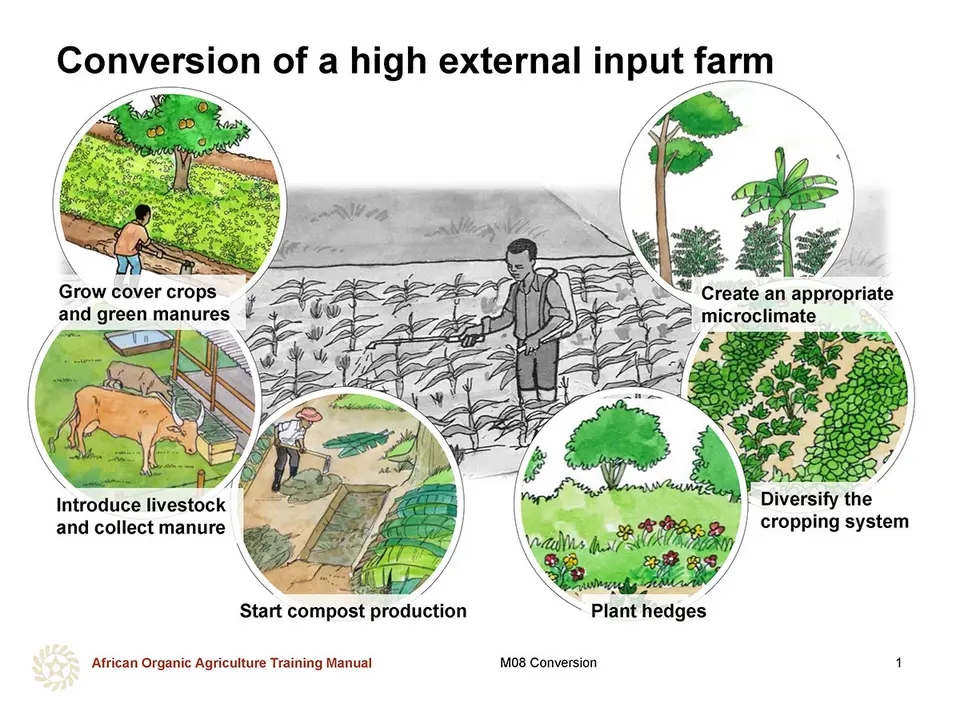
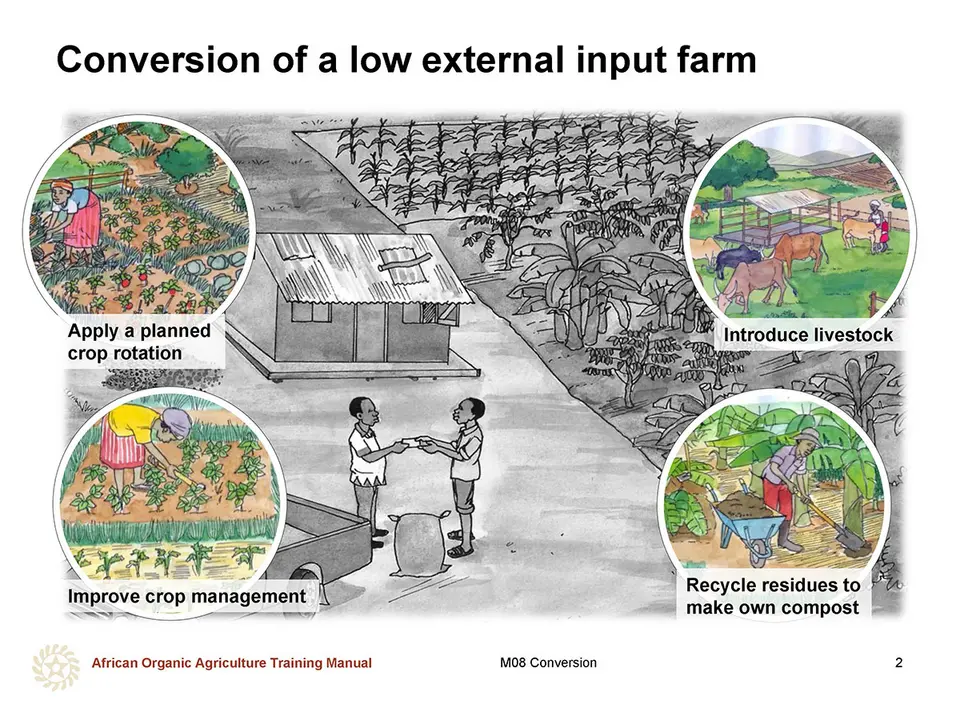
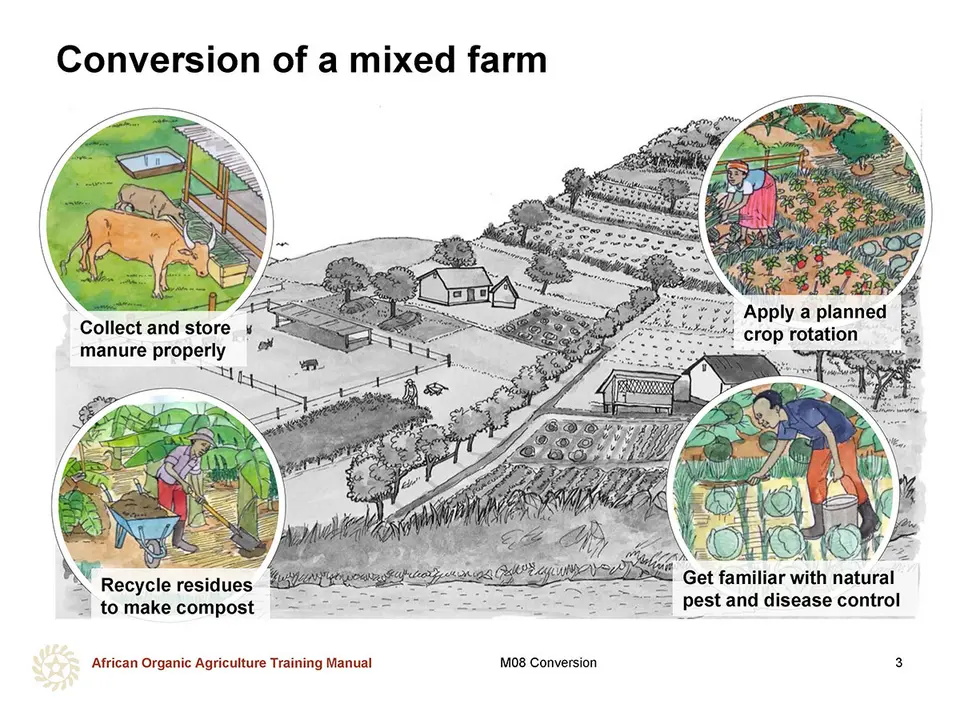
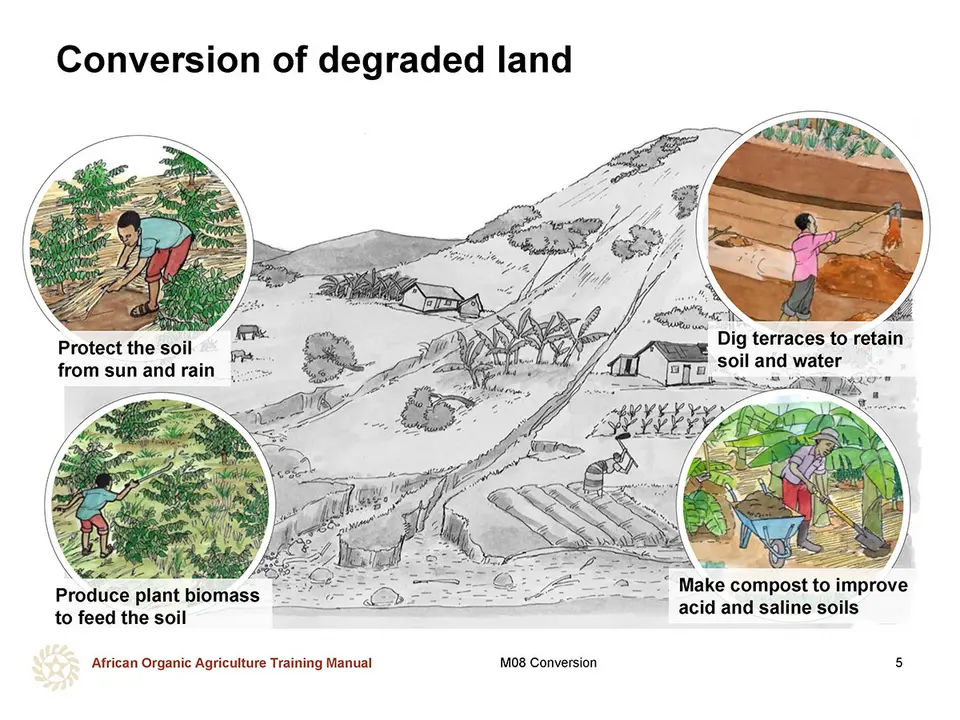
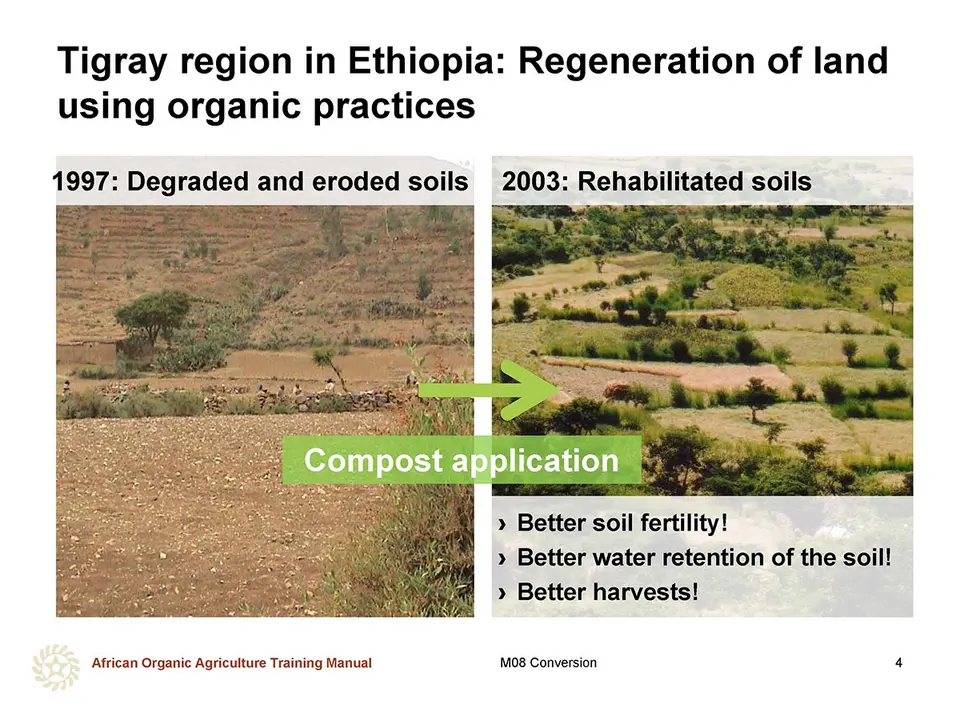
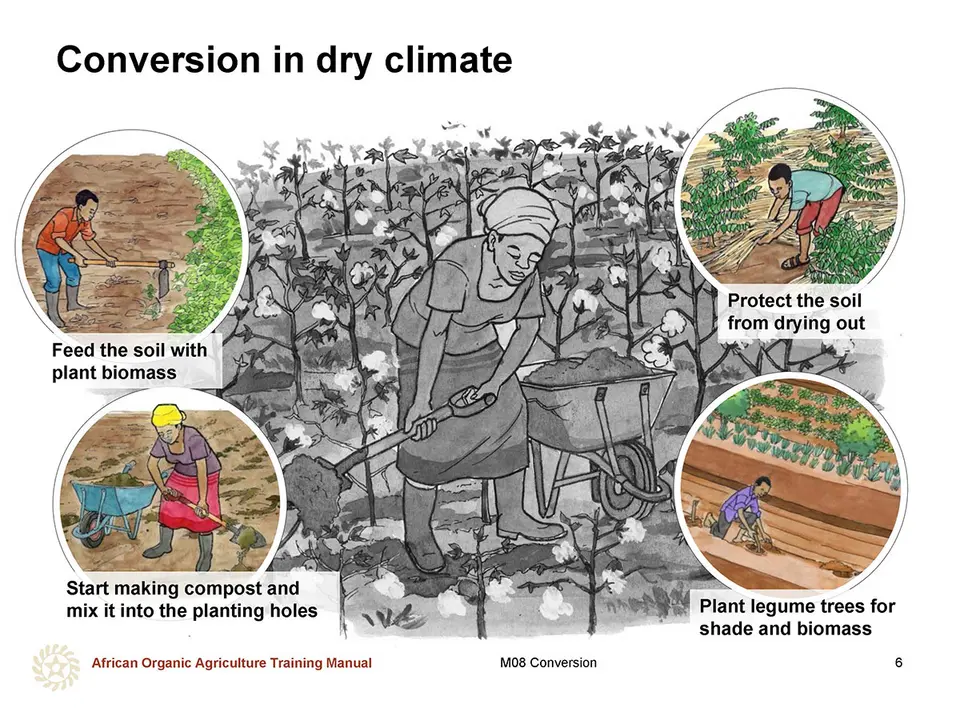
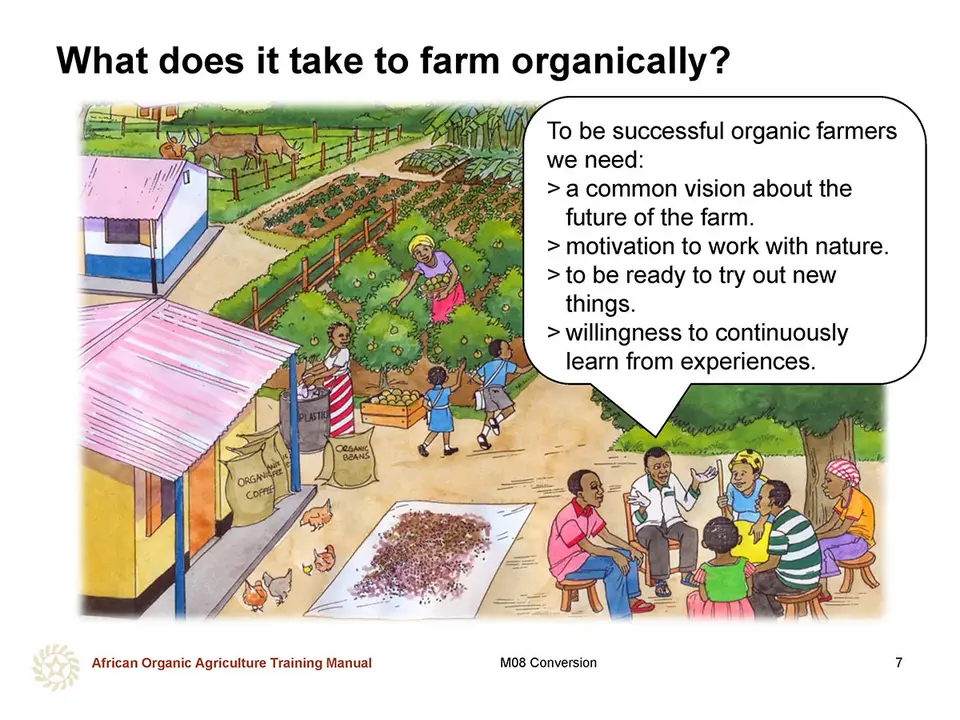
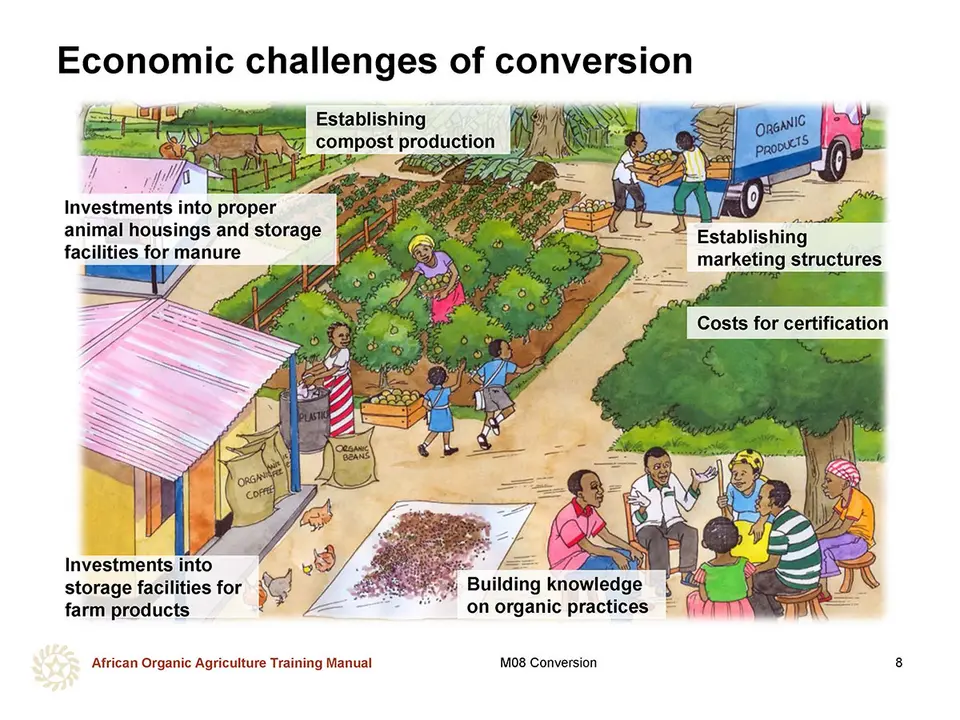
 tap and then scroll down to the Add to Home Screen command.
tap and then scroll down to the Add to Home Screen command.